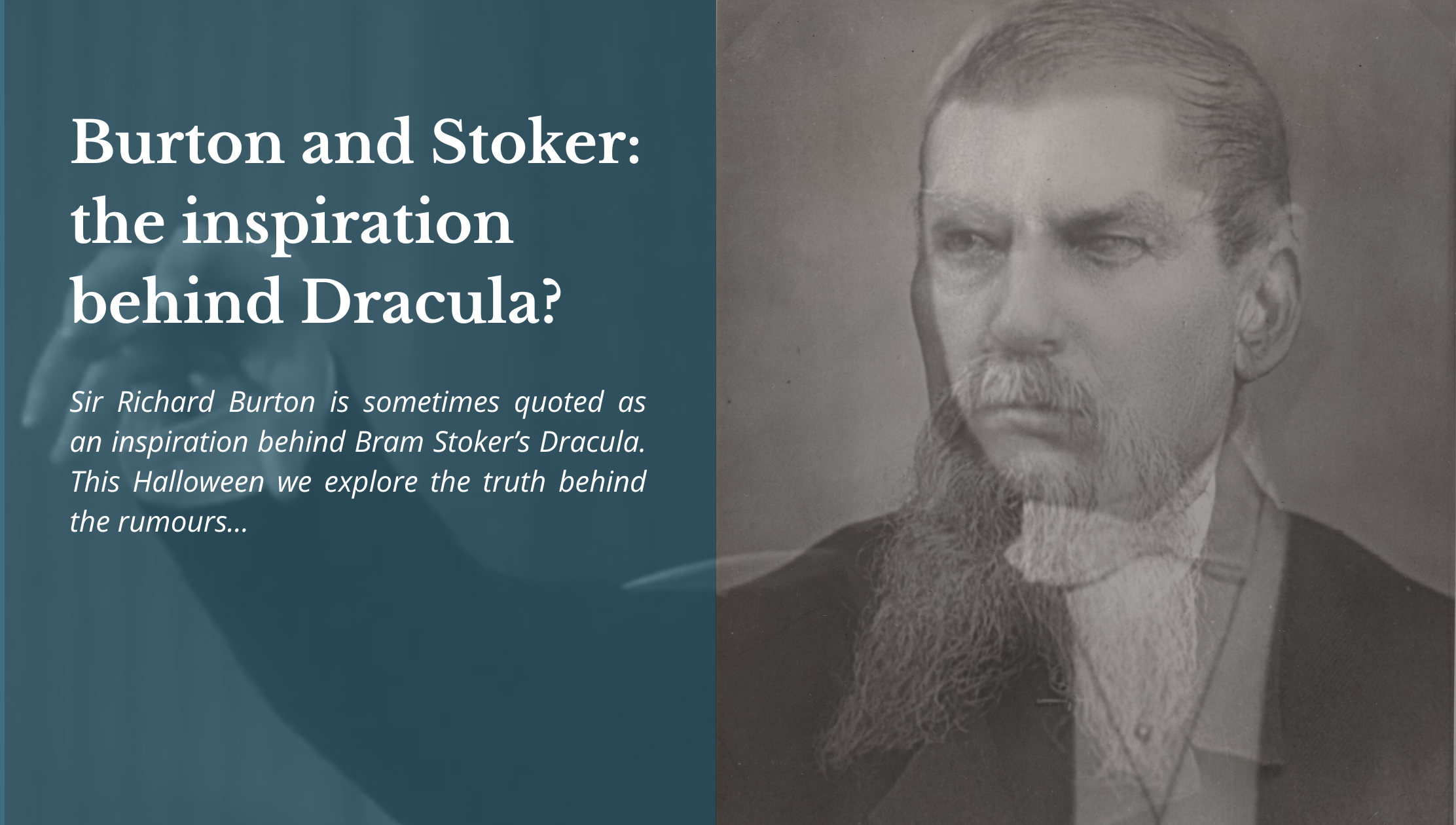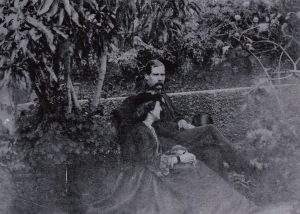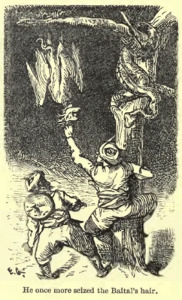
Stoker’s iconic Dracula was published in 1897, just seven years after the death of Sir Richard Burton. Described as tall, with a heavy moustache and sharp teeth, many readers have drawn parallels between Dracula and Burton over the years, quoting the similarity between Bram Stoker’s initial meeting with Burton and Jonathan Harker’s portrayal of the Count.
“The predominant characteristics were the darkness of the face – the desert burning; the strong mouth and nose, and jaw and forehead – the latter somewhat bold – and the strong, deep, resonant voice. My first impression of the man as of steel was consolidated and enhanced.” (Personal Reminiscences of Henry Irving p.225)
“His face was strong… with peculiarly arched nostrils; with domed forehead…The mouth, so far as I could see it under the heavy moustache, was fixed and rather cruel-looking” (Dracula p.24)
Stoker met Burton for the first time in Dublin in 1878. The Burtons had been travelling by train in a carriage with Henry Irving, the stage actor, on their way to visit Lord Talbot de Malahide north of the city. As Business Manager to the actor, and the Lyceum Theatre’s front of house man, Stoker was fortunate to be introduced to Irving’s literary London circle, helping the author to settle into his new home.
The brief introduction to Burton, as Stoker met Irving off the train, made a significant impression on the author, who exclaimed “I never saw any one like him. He is steel! He would go through you like a sword!”. Therein followed a series of meetings, dinner parties and theatre attendances between 1879 and 1886, with Stoker forming a good friendship with the Burtons.

Stoker recounts his meetings with Sir Richard Burton in his 1906 publication, The Personal Reminiscences of Henry Irving. In 1879, he was given the opportunity whilst sitting opposite the explorer to make a detailed study of his appearance, with his first impression of the man as of steel… consolidated and enhanced. During the following 7 years, Burton regaled Stoker with stories of his adventures, his work, with the translation of the Arabian Nights published in 1888, and his plans for his retirement. The younger author seems to have been entranced by the explorer and his thrilling tales,
“I remember when a lad hearing of how at a London dinner-party he told of his journey to Mecca… He saw that a lad had noticed him and was quietly stealing away. He faced the situation at once, and coming after the lad in such a way as not to arouse his suspicion suddenly stuck his knife into his heart…. I asked him once about the circumstance… He said it was quite true, and that it had never troubled him from that day to the moment at which he was speaking.” (Personal Reminiscences of Henry Irving p.229)
Bram Stoker started compiling his notes for Dracula in 1890, the year of Burton’s death. There has been much speculation about the inspiration behind Count Dracula, including historical figures such as Vlad the Impaler and the Countess Elizabeth Báthory. The character appears to be an amalgamation of influences, such as from Irish folklore and previous Gothic stories such as Sheridan Le Fanu’s 1872 Carmilla. It is possible, that Burton’s tales also inspired the author, as there are some parallels between Burton’s translation of Vikram and the Vampire: Or, Tales of Hindu Devilry, and some of the characteristics held by the Count. First published in 1870, and republished in 1893, the stories are centred around a Hindu baital, evil spririts that Burton translated as vampires, and the legendary King Vikramaditya. Whilst Dracula was able to transform into a bat, the Raja Vikram observes a figure;
‘…which hung, head downwards, from a branch a little above him… Its body was thin and ribbed like a skeleton or a bamboo framework, and as it held on to a bough, like a flying fox… Judging from these signs the brave king at once determined the creature to be a Baital — a Vampire.’ (Vikram and the Vampire, p46-7)

Stoker drew inspiration from many people that he met, with Irving’s ‘aquiline nose’ making a significant contribution. Burton himself seems to share some dental similarities with the vampire;
“As he spoke the upper lip rose and his canine tooth showed its full length like the gleam of a dagger.” (Personal Reminiscences of Henry Irving p.229)
“…peculiarly sharp white teeth; these protruded over the lips, whose remarkable ruddiness showed astonishing vitality in a man of his years.” (Dracula p.24)
Stoker even requested a photograph of Burton, which Lady Isabel obliged him with in 1886. Notwithstanding the similarities between Stoker’s descriptions of the two figures, the author was clearly enthralled by Burton’s stories of adventure and his depiction of the areas that the travelled.
“Burton knew the East. Its brilliant dawns and sunsets; its rich tropic vegetation, and its arid fiery deserts; its cool, dark mosques and temples; its crowded bazaars; its narrow streets; its windows guarded for out-looking and from in-looking eyes; the pride and swagger of its passionate men, and the mysteries of its veiled women; its romances; its beauty; its horrors.” (Personal Reminiscences of Henry Irving p.230)